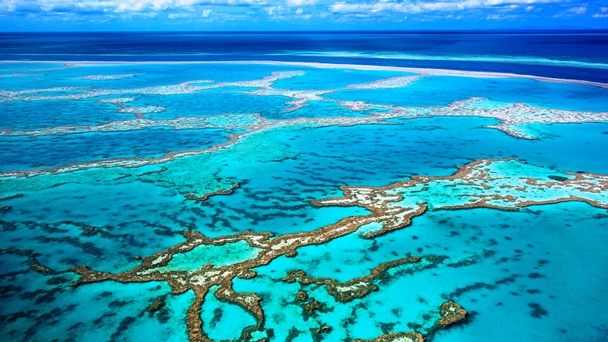Research into the depleted state of the Great Barrier Reef, one of the great wonders of the natural world, provides a vivid case study of the extreme harm that the warming climate and the affliction called coral bleaching cause globally. In March 2017, the journal Nature published data from aerial and underwater surveys of the Great Barrier Reef showing that coral bleaching was much more prevalent and severe than had been previously estimated. Overall, 91% of the reef displays some signs of bleaching, and about 50% of the reef is considered to be "extremely bleached" as the result of rising ocean water temperatures. Because of multiple bleaching events since the 1980s, the coral cover of the entire reef area has been halved. Although the reef has displayed great resiliency under growing ecological pressures, the unprecedented decimation of so much of the reef today is alarming scientists, who fear that the reef will not be able to bounce back to health. See also: Australia; Climate modification; Coral diseases; Corals and ocean acidification; Geologic history of reefs; Global climate change; Marine conservation; Marine ecology; Ocean warming; Reef

A barrier reef is a type of coral reef that runs parallel to the coast of an island or continent, separated from it by a lagoon. The most notable example is the Great Barrier Reef off the northeast coast of Australia, which is the largest living structure in the world: It extends 2300 km (1430 mi) along the coast and covers an area of 344,400 km2 (133,000 mi2). It comprises a chain of approximately 3000 individual reef structures at a distance ranging from 16 to 240 km (10 to 150 mi) offshore. To protect and conserve the reef, the area was declared a Marine Park in 1975 and has been listed as a World Heritage Site by the United Nations Educational, Scientific and Cultural Organization (UNESCO) since 1981. Although the reef continues to struggle from the degrading effects of tourism, agricultural runoff, and infestations of the predatory crown-of-thorns starfish (Acanthaster planci) that feed on growing coral, it is coral bleaching that is the prime destructive agent of the corals. See also: Conservation (species); Conservation of resources; Coral reef complexity; Environmental management; Environmental toxicology; Restoration ecology
Coral bleaching refers to a pathological breakdown in a symbiosis essential to the growth and survival of coral organisms. Reef ecosystems are dominated by stony corals called scleractinians, as well as a variety of other invertebrates, vertebrates, and plants. By secreting massive skeletons of calcium carbonate (CaCO3), scleractinians build coral reefs. Zooxanthellae (single-celled dinoflagellate algae) inhabit the tissues of scleractinians, where they receive a protected place to live and unlimited sunlight for photosynthesis. In return, they provide the coral with a vital supplement of extra energy in the form of food manufactured from sunlight and translocated to the coral directly through the cells. However, the reef-building corals can survive only within a narrow range of temperatures, normally 16–30°C (61–86°F). When the surrounding ocean water temperatures exceed those limits, as has been occurring in today's crisis of global climate change, the symbiotic relationship between the coral and the zooxanthellae breaks apart. The affected corals turn ghostly white, lose their zooxanthellae partners, and die. In some cases, the mortality rates due to coral bleaching may be as high as 80–100%. See also: Algae; Biodiversity; Ecological communities; Ecosystem; Endangered species; Extinction; Photosynthesis; Scleractinia; Symbiosis





